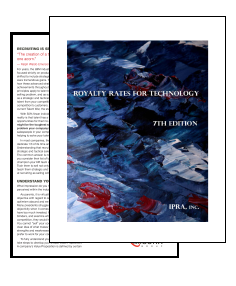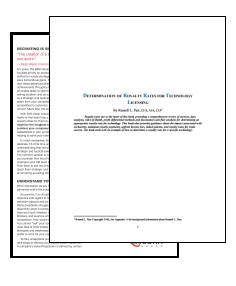Per Unit Royalties are Rare for Good Reason
In essence, royalties are a sharing of the economic benefits derived from the licensed property between the licensor and licensee. Paramount is the relative contributions of the licensee and licensor for commercial deployment of the licensed property. When a licensee must invest in product design, development, and testing, a lower royalty rate is indicated. When a licensee can easily and quickly incorporate a licensed property into its operations and profit making activities, a higher royalty rate is indicated.
Royalty rate negotiations based on the future expected earnings the licensed property will generate. Getting access to intellectual property through licensing involves a royalty payment. Royalties are based on sales or units. Royalties based on product sales link the licensor and licensee. As economic conditions change, royalty payments rise and fall with product pricing. Consequently, the licensor and licensee ride the economic roller coaster together. Not so with royalties based on per unit sales. Regardless of economic conditions, a royalty based on per unit sales remains constant regardless of changes in economic conditions and product pricing.
Examples of per unit royalties from Royalty Rates for Technology, 7th Edition include:
- Madison Avenue Capital, Inc. pays a royalty of $6 per tree for the licensing of a genetically enhanced tree.
- A-Gas Pty Ltd. of Australia licenses a proprietary enzyme-based fuel-enhancing product from Virtual Technologies Pty Ltd. A-Gas pays $4.75 per kilogram of product for production and distribution rights.
- Whelan Environmental Services, Ltd. licenses technology that allows for the refining of used oil from Interline Resources. Whelan pays a royalty of 6 cents per gallon of oil processed.
- Hybrid Fuel Systems, Inc. is in the business of manufacturing and marketing retrofit systems for the conversion of gasoline and diesel engines, stationary or vehicular, to non-petroleum based fuels such as compressed natural gas and liquefied natural gas. They pay Harrier, Inc. a royalty of $250 to $1,000 per engine.
- Allwaste Recycling Inc. licenses an advanced operational system that utilizes recycled broken glass (known as cullet), usually only suitable for landfills, to produce an end product the company has named “Glassflour”, a furnace-ready raw material for fiberglass insulation and potentially suitable for glass container manufacturers. Allwaste pays Eftek Corp. a royalty of $5 per ton.
License agreements are based on expectations. Both parties consider the extent to which the licensed property will be used. Both parties have knowledge about the market in which the property will be commercialized and have some idea about the level of sales that will be achieved and the length of time the property will be useful in the future. A running royalty is a pay-as-you-go scheme and protects both the licensee and licensor from unforeseen events. If future events exceed expectations, the licensor gets to participate in this happy event. When events are not as good as expected, the licensee does not end up paying for property that is not as useful as anticipated.
Per unit royalties, protect licensors from falling prices. In competitive industries, licensees often fight for market share using price competition. As product prices are reduced, royalties based on a percentage of sales may yield lower royalty payments for licensors. A per unit royalty provides protection but at a price. If product prices increase, a percent of revenues royalty scheme allows the licensor to enjoy a portion of increasing prices. A fixed per-unit royalty does not.
From the licensee’s viewpoint, if product prices are reduced, a fixed per unit royalty introduces pain for the licensee. Reduced pricing can hit the licensees profit margins but the licensor is unaffected. Resentment may follow and the relationship between the licensor and licensee is harmed. Per unit royalties doe not allow for the impact of a competitive marketplace and violate the fundamental aspect of licensing, which is a sharing of economic benefits derived from technology commercialization. Royalties based on unit sales can cause friction between dealmakers. Per unit royalties are typically avoided. The data in Royalty Rates for Technology, 7th Edition shows that per unit royalties are used in less than 10% of licensing deals.


